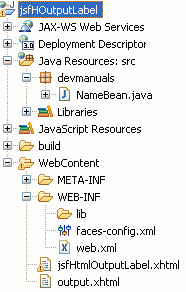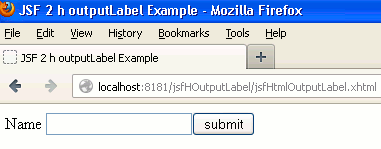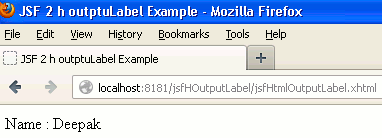In this tutorial you will learn about the JSF 2 h outputLabel tag.
JSF 2 h outputLabel
In this tutorial you will learn about the JSF 2 h outputLabel tag.
<h:outputLabel> tag of JSF 2 html tag library is rendered the HTML label element. This tag is used to specify the label text of the current component value. The for attribute of this tag (if used) specifies the target component is to be labeled. The value of 'for' attribute renders the targeted component's id value.
Attributes of JSF 2 h outputLabel
- converter : This is an optional attribute. This attribute is used when you are required to use any Converter class with this compoent.
- id : This is an optional attribute. This attribute is used
to make the component uniquely identifiable. The value of this attribute must be
unique within the closest parent component.
- rendered : This is an optional attribute. This attribute
evaluates a boolean expression. Presence of this attribute specifies that whether the
current component should be rendered in the Rendered Response phase or not or
worked on any later form submission. The default value of this attribute is
defined to true.
- value : This is an optional attribute. This attribute specifies the current value of the component.
- accesskey : This is an optional attribute. This attribute
evaluates the java.lang.String value, acted as an access key i.e used to create
a keyboard shortcut which can be accessed by the combination of
Alt+accesskeyValue or Alt+Shift+accesskeyValue (browser dependent combination) which transfers the
focus to the current element when it is pressed.
- dir : This is not a required attribute. This attribute
evaluates to the java.lang.String value that suggests the direction for the text
which doesn't inherit the property of maintaining a direction. The allowable
values are "LTR (Left-to-Right)" and "RTL (Right-to-Left)".
- escape : This is an optional attribute. This attribute is
used to specify whether the HTML, XML instructions must be escaped or not. If
this attribute is not used with this tag it is assumed that it's value is true
and the HTML, XML characters must not be executed.
- for : This is an optional attribute. This attribute specifies that which component has to be labeled. This attribute renders the target component's id's value.
- lang : This is an optional attribute. This attribute specifies the language code for the component.
- onblur : This is an optional attribute. This attribute
evaluates to a java.lang.String which specifies that on the lossing of element's
focus a Javascript code is executed.
- onclick : This is an optional attribute. This attribute
evaluates to a java.lang.String which specifies that on clicking of the mouse
pointer button on the current element a Javascript code is executed.
- ondblclick : This is an optional attribute. This attribute
evaluates to a java.lang.String which specifies that on the double clicking of
the current element by mouse pointer button a Javascript code will be executed.
- onfocus : This is an optional attribute. This attribute
evaluates to a java.lang.String which specifies that on geting focus of the
current element a Javascript code will be executed.
- onkeydown : This is an optional attribute. This attribute
evaluates to a java.lang.String which specifies that on pressing down of the key
over the current element a Javascript code is executed.
- onkeypress : This is an optional attribute. This attribute
evaluates to a java.lang.String value, specifies that when a key is pressed and
released throughout the current element a JavaScript code is executed.
- onkeyup : This is an optional attribute. This attribute
evaluates to a java.lang.String value, specifies that on releasing of key over
the current element a Javascript code is executed.
- onmousedown : This is an optional attribute. This attribute
evaluates to a java.lang.String value, specifies that on pressing down of the
mouse pointer button over the current element a Javascript code is executed.
- onmousemove : This is an optional attribute. This attribute
evaluates to a java.lang.String value, specifies that on moving of the mouse
pointer button inside the current element a Javascript code is executed.
- onmouseout : This is an optional attribute. This attribute
evaluates to a java.lang.String value, specifies that on moving away of the
mouse pointer button from the current element a Javascript code is executed.
- onmouseover : This is an optional attribute. This attribute
evaluates to a java.lang.String value, specifies that on moving of the mouse
pointer button onto the current element a Javascript code is executed.
- onmouseup : This is an optional attribute. This attribute
evaluates to a java.lang.String value, specifies that on releasing of mouse
pointer button above from the current element a Javascript code is executed.
- style : This is an optional attribute. This attribute
evaluates to a java.lang.String value, which specifies that the CSS style will
be applied to this component when rendered.
- styleClass : This is an optional attribute. This attribute
evaluates to a java.lang.String value specifies the applicable CSS style
space-separated list to applied at the time of rendering. "class" attribute must
be used to pass this value.
- tabindex : This is an optional attribute. This attribute
evaluates to a java.lang.String value specifies the tabbing order value. This
value must be
an integer within the range 0 to 32767.
- title : This is an optional attribute. This attribute is used to specify the title information which will be displayed as tooltip about the markup elements.
- binding : This is an optional attribute. This attribute evaluates to a javax.faces.component.UIComponent specified for linking the component with the property of backing bean.
Example :
Here is a simple example given for you which demonstrate about the use of JSF 2 h outputLabel tag. In this example a JSF view page has been created where the <h:outputLabel> tag is used.
Directory Structure

NameBean.java
package devmanuals;
import javax.faces.bean.ManagedBean;
import javax.faces.bean.RequestScoped;
@ManagedBean(name="nameBean")
@RequestScoped
public class NameBean {
String name;
public String getName() {
return name;
}
public void setName(String name) {
this.name = name;
}
}
jsfHtmlOutputLabel.xhtml
<!DOCTYPE html PUBLIC "-//W3C//DTD XHTML 1.0 Transitional//EN"
"http://www.w3.org/TR/xhtml1/DTD/xhtml1-transitional.dtd">
<html xmlns="http://www.w3.org/1999/xhtml"
xmlns:h="http://java.sun.com/jsf/html"
xmlns:f="http://java.sun.com/jsf/core">
<h:head>
<title>JSF 2 h outputLabel Example</title>
</h:head>
<h:body>
<f:view>
<h:form>
<h:outputLabel value="Name " for="text1"/>
<h:inputText id="text1" value="#{nameBean.name}"/>
<h:commandButton value="submit" action="output"/>
</h:form>
</f:view>
</h:body>
</html>
output.xhtml
<!DOCTYPE html PUBLIC "-//W3C//DTD XHTML 1.0 Transitional//EN"
"http://www.w3.org/TR/xhtml1/DTD/xhtml1-transitional.dtd">
<html xmlns="http://www.w3.org/1999/xhtml"
xmlns:h="http://java.sun.com/jsf/html"
xmlns:f="http://java.sun.com/jsf/core">
<h:head>
<title>JSF 2 h outptuLabel Example</title>
</h:head>
<h:body>
<h:outputLabel value="Name : " for="out1" />
<h:outputText id="out1" value="#{nameBean.name}"/>
</h:body>
</html>
web.xml
<?xml version="1.0" encoding="UTF-8"?> <web-app xmlns:xsi="http://www.w3.org/2001/XMLSchema-instance" xmlns="http://java.sun.com/xml/ns/javaee" xmlns:web="http://java.sun.com/xml/ns/javaee/web-app_2_5.xsd" xsi:schemaLocation="http://java.sun.com/xml/ns/javaee http://java.sun.com/xml/ns/javaee/web-app_3_0.xsd" id="WebApp_ID" version="3.0"> <display-name>jsfHOutputLabel</display-name> <welcome-file-list> <welcome-file>jsfHtmlOutputLabel.xhtml</welcome-file> </welcome-file-list> <servlet> <servlet-name>Faces Servlet</servlet-name> <servlet-class>javax.faces.webapp.FacesServlet</servlet-class> <load-on-startup>1</load-on-startup> </servlet> <servlet-mapping> <servlet-name>Faces Servlet</servlet-name> <url-pattern>/faces/*</url-pattern> <url-pattern>*.jsf</url-pattern> <url-pattern>*.xhtml</url-pattern> </servlet-mapping> <context-param> <description>State saving method: 'client' or 'server' (=default). See JSF Specification 2.5.2</description> <param-name>javax.faces.STATE_SAVING_METHOD</param-name> <param-value>client</param-value> </context-param> <context-param> <param-name>javax.servlet.jsp.jstl.fmt.localizationContext</param-name> <param-value>resources.application</param-value> </context-param> <listener> <listener-class>com.sun.faces.config.ConfigureListener</listener-class> </listener> <servlet-mapping> <servlet-name>Faces Servlet</servlet-name> <url-pattern>*.faces</url-pattern> </servlet-mapping> </web-app>
How To Run
After copying the above code paste them to the respective files or by downloading the code from Download Source Code start your web server and then use the following link http://localhost:8181/jsfHOutputLabel/jsfHtmlOutputLabel.xhtml in the address bar of the web browser.
Output :
When you will execute the above example you will get the output as follows :
1. The main page will look like as follows :

2. When you will enter the value to the provided text box and clicked on submit button then the output will be as follows :



[ 0 ] Comments